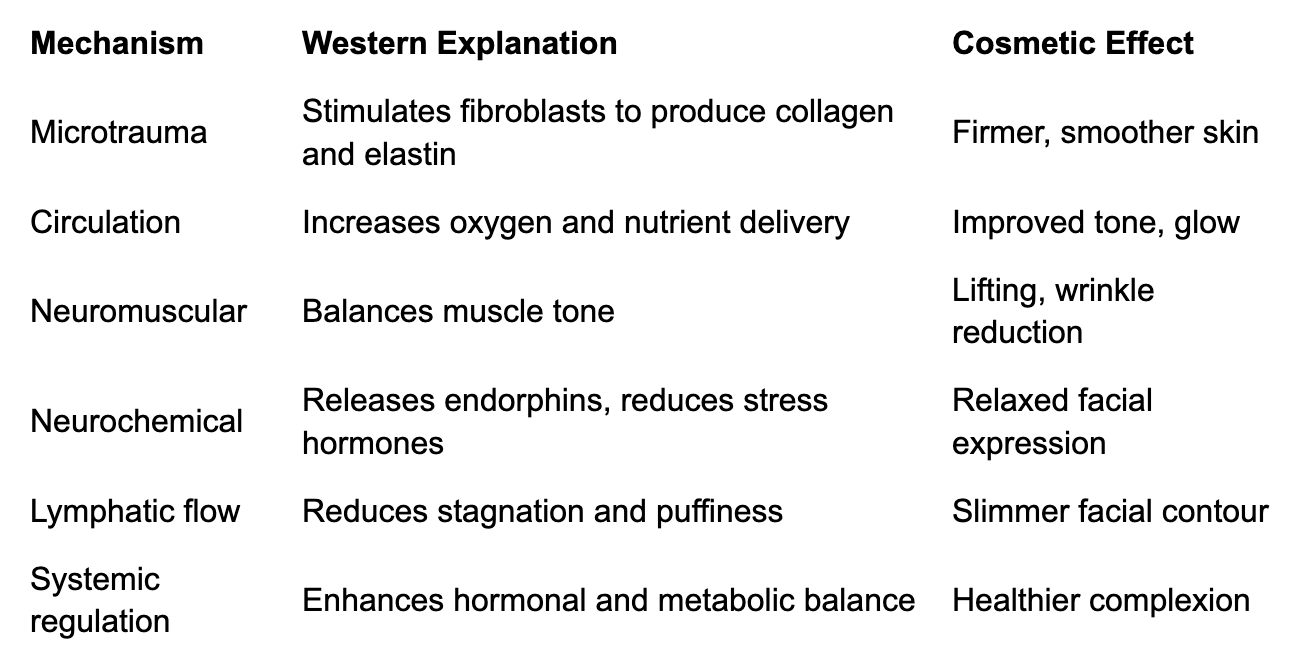Western Medical Principles of Cosmetic Acupuncture
By Grace Ge, DOM L.AC
Microtrauma and the Skin’s Healing Response
From a biomedical perspective, cosmetic acupuncture works primarily by creating controlled micro-injuries at specific points on the face. When fine acupuncture needles are inserted into the dermis or subdermal layers, they cause microtrauma that is too mild to cause scarring but strong enough to trigger the body’s natural wound-healing cascade.
This activates fibroblasts, which produce collagen and elastin—the key structural proteins that give skin firmness, elasticity, and smoothness. The result is gradual skin remodeling and improved texture, tone, and resilience over time.
Increased Local Circulation
Needling increases microcirculation (capillary blood flow) and lymphatic drainage in the treated area.
This enhanced circulation brings more oxygen, nutrients, and immune cells to the skin, supporting regeneration and detoxification. Further, improved lymphatic flow helps reduce edema, puffiness, and inflammation, creating a more sculpted and radiant appearance.
Neuromuscular Effects
Facial acupuncture also influences the facial nerves and muscles
Needling near motor points can gently relax overactive muscles (such as those that create expression lines) or stimulate weak muscles to lift sagging areas.
This neuromodulatory effect helps rebalance facial muscle tone, leading to a natural lifting and smoothing effect without injections.
Neurochemical and Hormonal Regulation
The insertion of needles triggers the release of various neurotransmitters and endorphins. Endorphins and enkephalins induce relaxation and enhance mood, reducing stress-related facial tension (a contributor to wrinkles).
The process can also influence the autonomic nervous system, shifting the body from “fight-or-flight” to a parasympathetic (“rest-and-repair”) state, which supports cellular repair and healthy skin metabolism.
Improved Skin Hydration and Barrier Function
Through enhanced local circulation and fibroblast activity, cosmetic acupuncture may improve the skin’s barrier function. In fact, increased collagen density and microvascular perfusion support better hydration retention and tissue oxygenation. This contributes to the “glow” or “radiance” patients often notice after treatments.
Systemic Effects
While the focus is on the face, cosmetic acupuncture often includes body points to regulate internal balance.
These systemic points can influence hormonal regulation, digestion, and sleep quality, all of which impact skin health.
In Western terms, this can be understood as optimizing homeostasis and reducing systemic inflammation, both beneficial for overall skin vitality.
Collagen Remodeling Timeline
Scientific understanding of collagen synthesis supports the observed effects.
During the Immediate phase (0–72 hours), the body displays an inflammatory and proliferative response, which is characterized by increased blood flow and fibroblast activation.
In the intermediate phase (2–6 weeks), collagen and elastin synthesis takes place, angiogenesis, and remodeling begin.
Long-term (6–12 weeks and beyond) yields strengthened extracellular matrix, improved elasticity, and visible firming of the skin.
Summary Table

